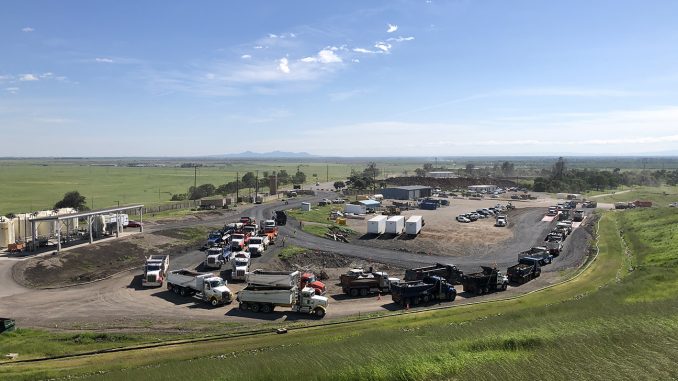
Butte County’s longest active construction site, Neal Road Recycling and Waste Facility opened as a sanitary landfill in 1970, the same year as the first Earth Day, and has buried more than seven million tons of Butte County’s solid waste. The 200-acre facility on the outskirts of Paradise has kept up with changing laws and growing demand. Operated by Butte County’s Department of Public Works, it also has come back from a catastrophic one-two blow.
“Over its 51-year history, Neal Road Landfill operations has encountered many challenges,” says Eric Miller, Manager of the Waste Management Division of Butte County Public Works. “None compare to the impacts of the Camp Fire in November 2018 and subsequent floods later that month and winter.”
The worst wildfire in California history, the Camp Fire killed 85 people and destroyed more than 18,800 structures, mostly in Paradise. The intense blaze ripped across the open space between the town and the landfill.
NRRWF’s crew defended the landfill. With gigantic Caterpillar D8 bulldozers, they cut fire breaks. Water trucks irrigated grassland along the site’s closed landfill areas.
The Camp Fire was so intense, it created its own weather; temperatures at NRRWF dropped 30 degrees as the massive black cloud obliterated the sky.
“On the morning of Nov. 9, 2018, the closed landfill areas were consumed by fire,” Miller says. “Of NRRWF’s 75 landfill gas (methane) collection wells, at least 35 were destroyed. Nearly three miles of high density polyethylene plastic piping and culverts, which manage landfill gas collection and storm water controls, were destroyed.”
The Camp Fire also hit NRRWF’s staff hard; half the crew was forced to evacuate along with their families. Many lived in Paradise; a third of them lost their homes.
Despite the damage, NRRWF managed to reopen four days after the fire—with a partial crew—before electricity was restored. NRRWF reduced its hours for two weeks to address immediate on-site damage and operated without internet for nearly a month. NRRWF managers communicated with regulatory agencies and engineering consultants using only smartphones.
Then, it started raining.
“The winter season of 2018-19 brought unusually high rainfall, with the first of three major storm events that occurred in late November 2018,” Miller says. That was only a few weeks after the Camp Fire; intense storm events kept up into March 2019.
NRRWF’s rain gauge for that winter measured more than 37 inches of rain, 42% above normal. The rain, on the heels of fire damage, created major issues and subsequent challenges.
“Over its 51-year history, Neal Road Landfill operations has encountered many challenges. None compare to the impacts of the Camp Fire in November 2018 and subsequent floods later that month and winter.”
Eric Miller
Manager, Waste Management Division, Butte County Public Works
“While the NRRWF is designed to accommodate storm water management, these intense storm events delivered up to 2 inches an hour, further damaging the site after being crippled by the Camp Fire,” Miller says. “The NRRWF spent $2 million to repair Camp Fire damage and another $1.84 million to repair damage from subsequent floods.”
Much of what was Paradise is now buried at Neal Road. NRRWF’s average intake jumped from 500-600 tons a day before the Camp Fire to a daily peak of 12,000 tons a day in July 2019. During Camp Fire clean-up, an estimated 170,000 vehicles—including nearly 60,000 dump trucks—delivered debris. NRRWF was one of three Northern Sacramento Valley landfills that received Camp Fire debris; landfills located in Yuba and Shasta counties buried the rest.
Landfills have a definitive “lifespan”; there’s only so much room within a site’s limits. The Camp Fire’s massive infusion took up a lot of NRRWF’s“air space”—enough for almost three years of service to Butte County.
How can NRRWF stretch its space and service as long as possible? The site has a projected capacity until about 2050. One step is a new approach to organic waste—anything that’s plant or animal based. Organic waste represents our state’s largest waste stream and is also a major source of methane gas when allowed to decompose in landfill.
The California Department of Resources Recycling and Recovery, in a 2018 study, reports that 34% of waste disposed in California municipal landfills includes organics. Nearly 10% of this material includes food waste. A new state law focuses on the diversion of organic waste (i.e. food waste and vegetative waste) to prolong landfill life. This organics waste stream will be directed to facilities to compost the material.
NRRWF and Butte County Department of Public Works are tackling these challenges while continuing to serve the needs of local residents—no matter what nature has in store.
Learn more at https://www.buttecounty.net/publicworks.

